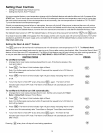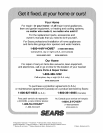
Before You Call
• Solutions to Common Problems (cont'd)
OCCURRENCE POSSIBLE CAUSE/SOLUTION
Oven smokes excessively during broiling. Meat is too close to the broil burner. Reposition the oven rack to provide more
clearance between the meat and the broiler burner.
Poor baking results.
Self-Cleaning cycle does not work.
Soil is not completely removed.
Excessive smoking from vent.
Meat not properly prepared. Remove excess fat from meat. Slash remaining fatty
edges to prevent curling, but do not cut into the lean.
Broiler pan used without insert or insert covered with foil. DO NOT use the broiler
pan without the insert or cover the insert with foil.
Broiler pan and insert needs to be cleaned. Excessive smoking is caused by a
build-up of grease or food spatters. If broiling often, clean on a regular basis (some
models).
Oven Door is open. Close the oven door before starting to broil.
Many factors affect baking results. Make sure the proper rack position is used.
Center food in the oven and space pans to allow air to circulate. Allow the oven to
preheat to the set temperature before placing food in the oven. Try adjusting the
recipe's recommended temperature or baking time. If you feel the oven is cooking
too hot or cool, see Adjusting Your Oven Temperature.
Controls are not set properly. Follow instructions in Self-Cleaning section.
Self-Cleaning cycle was interrupted. Stop time must be set 2 to 4 hours past the
start time. Follow steps under "Stopping or interrupting a Self-Clean Cycle" in the
Self-Cleaning section.
Failure to clean bottom front, top of oven or door areas outside oven seal. These
areas are not in the self-cleaning area, but get hot enough to burn on residue.
Clean these areas before starting the Self-Clean cycle. Burned-on residue may be
cleaned with a stiff nylon brush and water or a nylon scrubber. Be careful not to
damage the oven gasket.
Excessive spillovers in oven. Set Self-Cleaning cycle for a longer cleaning time.
Excessive spillovers in oven. This is normal, especially for pie spiliovers or large
amounts of grease on the oven bottom. Wipe up excessive spillovers before
starting the Self-Clean cycle, if flames or excessive smoke are present, stop the
Self-Clean cycle and follow the steps under "Stopping or Interrupting the Self-Clean
Cycle" in the Self-Cleaning section.
Scratchesorabrasionsoncooktopsurface Coarse particles such as salt or sand between cooktop and utensils can cause
(Ceramic Glass Cooktop models only), scratches. Be sure cooktop surface and bottoms of utensils are clean before usage.
Small scratches do not affect cooking and will become less visible with time.
Cleaning materials not recommended for ceramic-glass cooktop have been used. See
"Cooktop Cleaning and Maintenance" in the General Care & Cleaning section.
Cookware with rough bottom has been used. Use smooth, flat-bottomed cookware.
Metal marks
(Ceramic Glass Cooktop models only).
Sliding or scraping of metal utensils on cooktop surface. Do not slide metal utensils
on cooktop surface. Use a ceramic-glass cooktop cleaning creme to remove the marks.
See "Cooktop Cleaning and Maintenance" in the General Care & Cleaning section.
Brown streaks or specks Boilovers are cooked onto surface. Use razor blade scraper to remove soil. See
(Ceramic Glass Cooktop models only). "Cooktop Cleaning and Maintenance" in the General Care & Cleaning section.
Areas ofdiscoloration with metallic sheen Mineral deposits from water and food. Remove using a ceramic-glass cooktop cleaning
(Ceramic Glass Cooktop models only), creme. Use cookware with clean, dry bottoms.
42


















